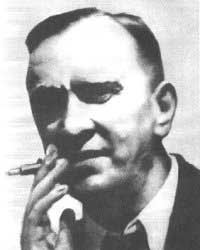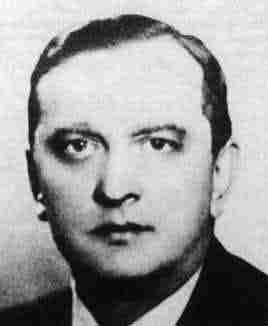<Back to Index>
- Mathematician Stephan Banach, 1892
PAGE SPONSOR


Stefan Banach (March 30, 1892 – August 31, 1945) was a Polish mathematician. He is generally considered to have been one of the 20th century's most important and influential mathematicians.
A self taught mathematics prodigy, Banach was the founder of modern functional analysis and a founder of the Lwów School of Mathematics. Among his most prominent achievements was the 1932 book, Théorie des opérations linéaires (Theory of Linear Operations), the first monograph on the general theory of functional analysis.
Notable mathematical concepts named after Banach include the Banach – Tarski paradox, the Hahn – Banach theorem, the Banach – Steinhaus theorem, the Banach - Mazur game, Banach algebra and the Banach space.
Stefan Banach was born on 30 March 1892 at St. Lazarus General Hospital in Kraków, then part of Austro - Hungarian Galicia. Banach's parents were Stefan Greczek and Katarzyna Banach, both natives of the Podhale region. Stefan Greczek was born in Ostrowsko near the town of Nowy Targ and at one time was a soldier in the Austro - Hungarian Army stationed in Kraków. Banach's mother left him after he was baptized at four days old.
Unusually, Stefan's surname was that of his mother instead of his
father, though he received his father's given name, Stefan. Since
Banach's father was a private and was prevented by military regulations
from marrying, and the mother was too poor to support the child, the
couple decided that he should be reared by family and friends.
As a result Stefan Banach was raised by Franciszka Płowa, her niece
Maria Puchalska and their close family friend, Juliusz Mien.
In 1902 Banach, aged 10, enrolled in Kraków's Henryk Sienkiewicz Gymnasium (commonly known as Goetz after the building's owner, Jan Albin Goetz). Despite the fact that the school specialized in the humanities Banach and his best friend Witold Wiłkosz, a future mathematician, would regularly work on mathematics problems during school breaks and after school. Later in life Banach would credit Dr. Kamil Kraft, the mathematics and physics teacher at the gymnasium with kindling his interests in mathematics.
After obtaining his matura at age 18 in 1910, Banach, together with Wiłkosz, moved to Lwów, then the capital of Galicia, with the intention of studying at the Lwów Polytechnic. His initial field of study was engineering since at the time Banach was convinced that there was nothing new to discover in mathematics. At some point he also attended Jagiellonian University in Krakow on part time basis. As Banach had to earn money to support his studies it was not until 1914 that he finally, at age 22, passed his high school graduation exams.
When World War I broke out, Banach was excused from military service due to his left handedness and poor vision. When the Russian Army opened its offensive toward Lwów, Banach left for Kraków, to spend the rest of the war there. He made his living as a tutor at the local gymnasiums and worked in a bookshop. He may have attended lectures at the Jagiellonian University, but little is known of that period in his life.
In 1916, in Kraków's Planty gardens, Banach encountered Professor Hugo Steinhaus,
one of the renowned mathematicians of the time. According to Steinhaus,
while he was strolling through the gardens he was surprised to over
hear the term "Lebesgue integral" (Lebesgue integration was at
the time still a fairly new idea in mathematics) and walked over to
investigate. As a result he met Banach, as well as Otto Nikodym and Wilkosz.
Steinhaus became fascinated with the self taught young mathematician.
The encounter resulted in a long lasting collaboration and friendship.
In fact, soon after the encounter Steinhaus invited Banach to solve some
problems he had been working on but which had proven difficult. Banach
solved them within a week and the two soon published their first joint
work (On the Mean Convergence of Fourier Series). It was also through Steinhaus that Banach met his future wife, Łucja Braus.
Steinhaus introduced Banach to academic circles and substantially accelerated his career. After Poland regained independence, in 1920 Banach was given an assistantship at Kraków's Jagiellonian University. Steinhaus' backing also allowed him to receive a doctorate without actually graduating from a university. The doctoral thesis, accepted by King John II Casimir University of Lwów and published in 1922, included the basic ideas of functional analysis, which was soon to become an entirely new branch of mathematics. The thesis was widely discussed in academic circles and allowed him in 1922 to become a professor at the Lwów Polytechnic. Initially an assistant to Professor Antoni Łomnicki, in 1927 Banach received his own chair. In 1924 he was also accepted as a member of the Polish Academy of Learning. At the same time, from 1922, Banach also headed the second Chair of Mathematics at University of Lwów.
Young and talented, Banach gathered around him a large group of
mathematicians. The group, meeting in the Scottish Café, soon gave birth
to the "Lwów School of Mathematics". In 1929 the group began publishing
its own journal, Studia Mathematica, devoted primarily to Banach's field of study — functional analysis.
Around that time, Banach also began working on his best known work, the
first monograph on the general theory of linear - metric space. First published in Polish in 1931, the following year it was also translated into French and gained wider recognition in European academic circles. The book was also the first in a long series of mathematics monographs edited by Banach and his circle.
Following the invasion of Poland by Nazi Germany and the Soviet Union, Lwów came under the control of the Soviet Union for almost two years. Banach, from 1939 a corresponding member of the Academy of Sciences of Ukraine, and on good terms with Soviet mathematicians, had to promise to learn Ukrainian to be allowed to keep his chair and continue his academic activities. Following the German takeover of Lwów in 1941 during Operation Barbarossa, all universities were closed and Banach, along with many colleagues and his son, was employed as lice feeder at Professor Rudolf Weigl's Typhus Research Institute. Employment in Weigl's Institute provided many unemployed university professors and their associates protection from random arrest and deportation to Nazi concentration camps.
After the Red Army recaptured Lviv
in the Lvov – Sandomierz Offensive of 1944, Banach returned to the
University and helped re-establish it after the war years. However,
because the Soviets were removing Poles
from annexed formerly Polish territories, Banach began preparing to
leave the city and settle in Kraków, Poland, where he had been promised a
chair at the Jagiellonian University. He was also considered a candidate for Minister of Education of Poland.
In January 1945, however, he was diagnosed with lung cancer and was
allowed to stay in Lwów. He died on August 31, 1945, aged 53. His
funeral at the Lychakiv Cemetery turned into a patriotic demonstration by the Poles who still remained in the city.
Banach's most influential work was Théorie des opérations linéaires (Theory of Linear Operations, 1932). In it he formulated the concept now known as "Banach space", and proved many fundamental theorems of functional analysis.
Besides being one of the founders of functional analysis, Banach also made important contributions to measure theory, set theory, and other branches of mathematics.
He was also one of the founders and editors of the journal, Studia Mathematica.
Stanisław Ulam, another mathematician of the Lwów School of Mathematics, in his autobiography, quotes Banach as saying:
- "Good mathematicians see analogies. Great mathematicians see analogies between analogies."
Hugo Steinhaus said of Banach:
- "An exceptional intellect, exceptional discoveries... he gave Polish science... more than anybody else."
- "Banach was my greatest scientific discovery."